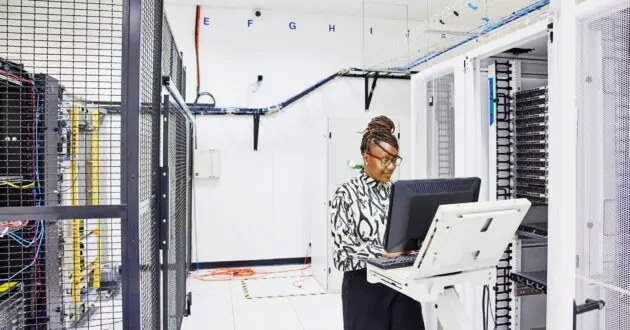<!—->
<!– –>

In today’s rapidly changing landscape, delivering higher-quality products to the market faster is essential for success. Many industries rely on high-performance computing (HPC) to achieve this goal.
Enterprises are increasingly turning to generative artificial intelligence (gen AI) to drive operational efficiencies, accelerate business decisions and foster growth. We believe that the convergence of both HPC and artificial intelligence (AI) is key for enterprises to remain competitive.
These innovative technologies complement each other, enabling organizations to benefit from their unique values. For example, HPC offers high levels of computational power and scalability, crucial for running performance-intensive workloads. Similarly, AI enables organizations to process workloads more efficiently and intelligently.
In the era of gen AI and hybrid cloud, IBM Cloud® HPC brings the computing power organizations need to thrive. As an integrated solution across critical components of computing, network, storage and security, the platform aims to assist enterprises in addressing regulatory and efficiency demands.
How AI and HPC deliver results faster: Industry use cases
At the very heart of this lies data, which helps enterprises gain valuable insights to accelerate transformation. With data nearly everywhere, organizations often possess an existing repository acquired from running traditional HPC simulation and modeling workloads. These repositories can draw from a multitude of sources. By using these sources, organizations can apply HPC and AI to the same challenges, enabling them to generate deeper, more valuable insights that drive innovation faster.
AI-guided HPC applies AI to streamline simulations, known as intelligent simulation. In the automotive industry, intelligent simulation speeds up innovation in new models. As vehicle and component designs often evolve from previous iterations, the modeling process undergoes significant changes to optimize qualities like aerodynamics, noise and vibration.
With millions of potential changes, assessing these qualities across different conditions, such as road types, can greatly extend the time to deliver new models. However, in today’s market, consumers demand rapid releases of new models. Prolonged development cycles might harm automotive manufacturers’ sales and customer loyalty.
Automotive manufacturers, having a wealth of data related to existing designs, can use these large bodies of data to train AI models. This enables them to identify the best areas for vehicle optimization, thereby reducing the problem space and focusing traditional HPC methods on more targeted areas of the design. Ultimately, this approach can help to produce a better-quality product in a shorter amount of time.
In electronic design automation (EDA), AI and HPC drive innovation. In today’s rapidly changing semiconductor landscape, billions of verification tests must validate chip designs. However, if an error occurs during the validation process, it is impractical to re-run the entire set of verification tests due to the resources and time required.
For EDA companies, using AI-infused HPC methods is important for identifying the tests that need to be re-run. This can save a significant amount of compute cycles and help keep manufacturing timelines on track, ultimately enabling the company to deliver semiconductors to customers more quickly.
How IBM helps support HPC and AI compute-intensive workloads
IBM designs infrastructure to deliver the flexibility and scalability necessary to support HPC and compute-intensive workloads like AI. For example, managing the vast volumes of data involved in modern, high-fidelity HPC simulations, modeling and AI model training can be critical, requiring a high-performance storage solution.
IBM Storage Scale is designed as a high-performance, highly available distributed file and object storage system capable of responding to the most demanding applications that read or write large amounts of data.
As organizations aim to scale their AI workloads, IBM watsonx™ on IBM Cloud® helps enterprises to train, validate, tune and deploy AI models while scaling workloads. Also, IBM offers graphics processing unit (GPU) options with NVIDIA GPUs on IBM Cloud, providing innovative GPU infrastructure for enterprise AI workloads.
However, it’s important to note that managing GPUs remains necessary. Workload schedulers such as IBM Spectrum® LSF® efficiently manage job flow to GPUs, while IBM Spectrum Symphony®, a low-latency, high-performance scheduler designed for the financial services industry’s risk analytics workloads, also supports GPU tasks.
Regarding GPUs, various industries requiring intensive computing power use them. For example, financial services organizations employ Monte Carlo methods to predict outcomes in scenarios such as financial market movements or instrument pricing.
Monte Carlo simulations, which can be divided into thousands of independent tasks and run simultaneously across computers, are well-suited for GPUs. This enables financial services organizations to run simulations repeatedly and swiftly.
As enterprises seek solutions for their most complex challenges, IBM is committed to helping them overcome obstacles and thrive. With security and controls built into the platform, IBM Cloud HPC allows clients across industries to consume HPC as a fully managed service, addressing third-party and fourth-party risks. The convergence of AI and HPC can generate intelligence that adds value and accelerates results, assisting organizations in maintaining competitiveness.
Learn how IBM can help accelerate innovation with AI and HPC
Was this article helpful?
YesNo
More from IT infrastructure

March 21, 2024
Unleashing the potential: 7 ways to optimize Infrastructure for AI workloads
3 min read – Artificial intelligence (AI) is revolutionizing industries by enabling advanced analytics, automation and personalized experiences. Enterprises have reported a 30% productivity gain in application modernization after implementing Gen AI. However, the success of AI initiatives heavily depends on the underlying infrastructure’s ability to support demanding workloads efficiently. In this blog, we’ll explore seven key strategies to optimize infrastructure for AI workloads, empowering organizations to harness the full potential of AI technologies. 1. High-performance computing systems Investing in high-performance computing systems tailored…

March 20, 2024
Migrate and modernize enterprise integration using IBM Cloud Pak for Integration with Red Hat OpenShift Service on AWS (ROSA)
5 min read – Integration is essential to every business. As businesses consider the core of their IT infrastructure, their focus might be on their data and applications. But without integration, the data would be locked into siloes; and the applications would be isolated and overloaded with complexity as fragile, tightly coupled connections were added to allow applications to work together and share information. This impacts business agility—slowing both actions—and the ability to change. Businesses are trying to reduce these data exchange barriers through…

February 22, 2024
IBM Cloud delivers enterprise sovereign cloud capabilities
5 min read – As we see enterprises increasingly face geographic requirements around sovereignty, IBM Cloud® is committed to helping clients navigate beyond the complexity so they can drive true transformation with innovative hybrid cloud technologies. We believe this is particularly important with the rise of generative AI. While AI can undoubtedly offer a competitive edge to organizations that effectively leverage its capabilities, we have seen unique concerns from industry to industry and region to region that must be considered—particularly around data. We strongly…
IBM Newsletters
Get our newsletters and topic updates that deliver the latest thought leadership and insights on emerging trends.
Subscribe now
More newsletters
- SEO Powered Content & PR Distribution. Get Amplified Today.
- PlatoData.Network Vertical Generative Ai. Empower Yourself. Access Here.
- PlatoAiStream. Web3 Intelligence. Knowledge Amplified. Access Here.
- PlatoESG. Carbon, CleanTech, Energy, Environment, Solar, Waste Management. Access Here.
- PlatoHealth. Biotech and Clinical Trials Intelligence. Access Here.
- Source: https://www.ibm.com/blog/the-convergence-of-hpc-and-ai-driving-innovation-at-speed/
- :is
- $UP
- 00
- 1
- 2%
- 20
- 2024
- 21
- 22
- 28
- 29
- 300
- 39
- 4
- 400
- 5
- 52
- 6
- 7
- 9
- a
- ability
- accelerate
- accelerates
- Achieve
- acquired
- across
- Adam
- added
- addressing
- Adds
- advanced
- Advertising
- After
- AI
- AI models
- aim
- aims
- All
- allow
- allows
- also
- amount
- amounts
- amp
- an
- analytics
- and
- Application
- applications
- applies
- Apply
- approach
- ARE
- areas
- around
- article
- artificial
- artificial intelligence
- AS
- Assessing
- assist
- assisting
- At
- author
- Automation
- automotive
- automotive industry
- available
- AWS
- back
- barriers
- BE
- believe
- benefit
- BEST
- Beyond
- billions
- Blog
- Blue
- bodies
- both
- boxes
- Brings
- built
- business
- businesses
- but
- button
- by
- CAN
- capabilities
- capable
- carbon
- card
- Cards
- CAT
- Category
- challenges
- change
- Changes
- changing
- check
- chip
- circles
- class
- clients
- Cloud
- cloud HPC
- colleagues
- color
- committed
- Companies
- company
- competitive
- competitiveness
- Complement
- complex
- complexity
- component
- components
- computational
- computational power
- Compute
- computers
- computing
- computing power
- Concerns
- conditions
- Connections
- Consider
- consume
- Consumers
- Container
- continue
- controls
- Convergence
- copy
- Core
- country
- coupled
- critical
- crucial
- CSS
- custom
- customer
- Customer Loyalty
- Customers
- cycles
- data
- Data Exchange
- Date
- decisions
- deeper
- Default
- definitions
- deliver
- deliver results
- delivering
- delivers
- Demand
- demanding
- demands
- depends
- deploy
- description
- Design
- designed
- designs
- Development
- different
- distributed
- divided
- draw
- drive
- driving
- due
- during
- each
- earth
- Edge
- effectively
- efficiencies
- efficiency
- efficiently
- Electronic
- emerging
- empowering
- enables
- enabling
- Enter
- Enterprise
- enterprises
- Entire
- Era
- error
- essential
- Ether (ETH)
- Every
- everywhere
- evolve
- example
- exchange
- existing
- Exit
- Experiences
- explore
- extend
- Face
- false
- faster
- February
- File
- financial
- Financial Market
- financial services
- Flexibility
- flow
- Focus
- focusing
- follow
- fonts
- For
- Foster
- from
- full
- fully
- Gain
- Gen
- generate
- generative
- Generative AI
- generator
- geographic
- get
- goal
- GPU
- GPUs
- graphics
- greatly
- Grid
- Growth
- harm
- harness
- hat
- Have
- having
- Heading
- Heart
- heavily
- height
- help
- helpful
- helping
- helps
- High
- high-performance
- highly
- How
- However
- hpc
- HTTPS
- Hybrid
- hybrid cloud
- IBM
- IBM Cloud
- ICO
- ICON
- identify
- identifying
- if
- image
- Impacts
- implementing
- important
- impractical
- in
- increasingly
- independent
- index
- industries
- industry
- industry’s
- informal
- information
- Infrastructure
- initiatives
- Innovation
- innovative
- innovative technologies
- insights
- instrument
- integrated
- integration
- Intelligence
- Intelligent
- intensive
- into
- investing
- involved
- isolated
- IT
- iterations
- ITS
- Job
- jpg
- Keep
- Key
- known
- landscape
- large
- latest
- Leadership
- levels
- Leverage
- lies
- lights
- like
- ll
- local
- locale
- locked
- Loyalty
- maintaining
- manage
- managed
- managing
- Manufacturers
- manufacturing
- many
- March
- Market
- max-width
- meeting
- methods
- might
- migrate
- millions
- min
- minutes
- Mobile
- model
- modeling
- models
- Modern
- modernization
- modernize
- more
- most
- movements
- multitude
- must
- Navigate
- Navigation
- nearly
- necessary
- Need
- network
- New
- Newsletters
- Noise
- note
- nothing
- now
- Nvidia
- object
- Object Storage
- obstacles
- of
- off
- offer
- Offers
- often
- on
- operational
- optimization
- Optimize
- optimized
- Options
- or
- organizations
- Other
- our
- outcomes
- Overcome
- page
- particularly
- Personalized
- PHP
- picture
- platform
- plato
- Plato Data Intelligence
- PlatoData
- plugin
- policy
- position
- possess
- Post
- potential
- power
- predict
- previous
- pricing
- primary
- Problem
- process
- processing
- produce
- Product
- productivity
- Products
- professional
- providing
- qualities
- quickly
- rapid
- rapidly
- Read
- Reading
- Red
- Red Hat
- reduce
- reducing
- region
- regulatory
- related
- Releases
- rely
- remain
- remains
- REPEATEDLY
- Reported
- repository
- required
- Requirements
- Resources
- responding
- responsive
- Results
- Revolutionizing
- Rise
- Risk
- risks
- road
- robots
- Room
- ROSA
- Run
- running
- s
- sales
- same
- Save
- Scalability
- Scale
- scaling
- scenarios
- Screen
- scripts
- security
- see
- Seek
- seen
- semiconductor
- Semiconductors
- seo
- server
- service
- Services
- set
- seven
- Share
- share information
- shorter
- showing
- significant
- Similarly
- simulation
- simulations
- simultaneously
- site
- small
- So
- solution
- Solutions
- Sources
- sovereign
- sovereignty
- Space
- Spectrum
- speed
- speeds
- Sponsored
- squares
- start
- storage
- strategies
- streamline
- subscribe
- success
- such
- support
- Supports
- SVG
- swiftly
- system
- Systems
- targeted
- tasks
- Technologies
- tertiary
- tests
- thanks
- that
- The
- their
- Them
- theme
- thereby
- These
- they
- third-party
- this
- thought
- thought leadership
- thousands
- Thrive
- tightly
- time
- timelines
- Title
- to
- today’s
- together
- top
- topic
- track
- traditional
- Train
- Training
- Transformation
- Trends
- true
- trying
- tune
- Turning
- type
- types
- Ultimately
- undergoes
- underlying
- undoubtedly
- unique
- unit
- unleashing
- Updates
- URL
- use
- using
- VALIDATE
- validation
- Valuable
- value
- Values
- various
- Vast
- vehicle
- Verification
- very
- volumes
- W
- Warehouse
- ways
- we
- Wealth
- were
- which
- while
- with
- without
- WordPress
- Work
- work together
- would
- write
- written
- Your
- zephyrnet












